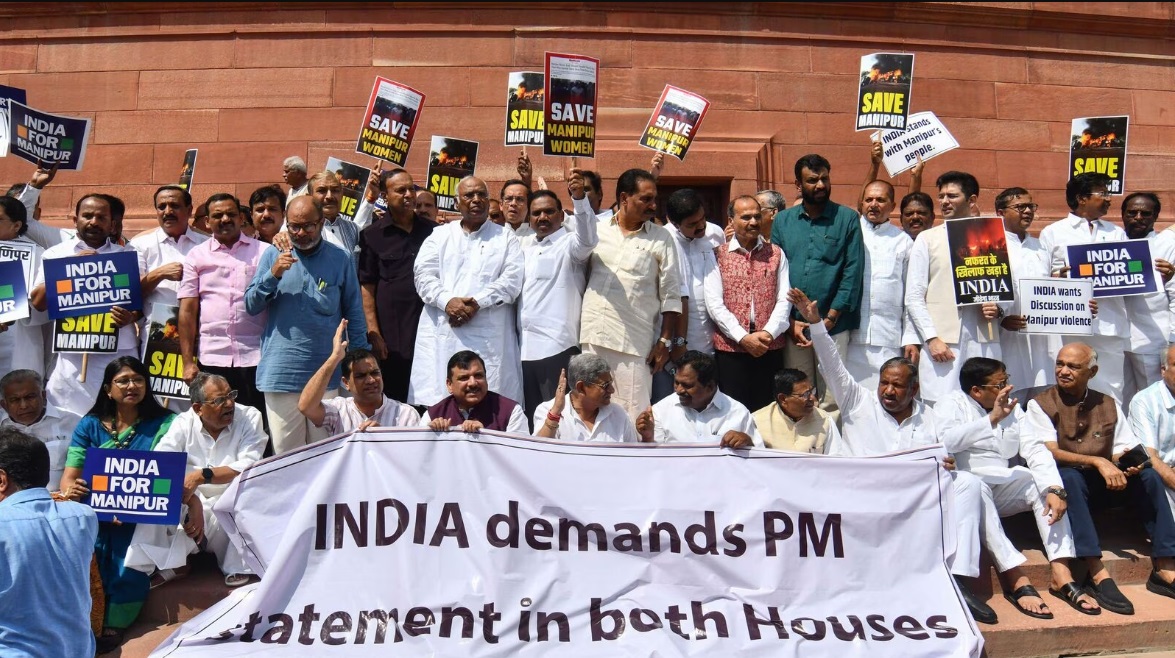Why no-confidence motion in news?
In the Lok Sabha, both the Congress party and K Chandrashekar Rao’s Bharat Rashtra Samithi (TRS) separately submitted notices for a no-confidence motion against Prime Minister Narendra Modi’s government. The motion was related to the Manipur issue. Subsequently, the no-confidence motion was accepted by the Speaker.
Following the acceptance of the motion, the Opposition has been persistently demanding that Prime Minister Modi addresses the issue in the House. The demand for the Prime Minister’s presence and response during the debate on the motion reflects the seriousness of the matter and the desire for accountability from the government on the Manipur issue.
What is no-confidence motion?
In Lok Sabha, any member of the house has the exclusive right to propose a no-confidence motion. This motion can only be moved if the member believes that the current government lacks a majority. Once the Speaker accepts the motion, the ruling party in the Centre must prove its majority in the House.
It is important to note that the opposition parties hold less than 150 seats in the Lower House. Consequently, if they decide to table a no-confidence motion, it is highly likely that they will face defeat due to their limited numerical strength. Additionally, during the debate in Lok Sabha, the time allotted for each party is determined according to its strength in the House. This means that the opposition may not receive substantial debate time due to their smaller representation.
Rules of No-confidence motion rules
In Lok Sabha, for a no-confidence motion to be initiated, a member must submit a written notice of the motion before 10 am. The Speaker will then read out the notice in the House. To proceed with the motion, at least 50 members need to support and accept it.
Once accepted, the motion must be scheduled for debate within 10 days from the date of acceptance; otherwise, the motion will fail. During the debate, the ruling government must demonstrate its majority in the House. If the government fails to prove its majority, it will be required to resign from power. This process ensures accountability and provides a mechanism for the House to express its lack of confidence in the ruling government.
Flashback on no-confidence motion in Indian politics
In the history of Indian politics since Independence, a total of 27 no-confidence motions have been moved in Lok Sabha.
- The first two no-confidence motions were directed against Prime Minister Jawaharlal Nehru by Congress leader Acharya Kripalani in August 1963. These motions were brought immediately after India’s defeat to China in the 1962 war.
- Indira Gandhi holds the record for facing the highest number of no-confidence motions as Prime Minister, with a total of 15. However, she successfully survived each of these 15 floor tests, managing to retain her position.
- Other Prime Ministers who faced no-confidence motions include Narasimha Rao (3 motions), Morarji Desai (2 motions), Jawaharlal Nehru, Rajiv Gandhi, Atal Bihari Vajpayee, and Narendra Modi, each facing one motion during their respective tenures.
- The most recent no-confidence motion took place in 2003 when Congress president Sonia Gandhi moved the motion against Prime Minister Atal Bihari Vajpayee.
- Throughout these motions, most have been defeated in the Lok Sabha, with only two exceptions. In 1979, Prime Minister Morarji Desai had to resign after a successful no-confidence motion, and in 1999, the Vajpayee-led government lost power due to another no-confidence motion.
- In 2018, the Narendra Modi-led NDA government faced a no-confidence motion and survived it with 195 votes in their favor. The motion garnered support from 135 members, while 330 MPs rejected it, ensuring the government’s continuation.
Find More General Studies News Here




 Which Indian City is Known as the Footwe...
Which Indian City is Known as the Footwe...
 Which Desert is known as the Cold Desert...
Which Desert is known as the Cold Desert...
 Top-10 News Media Companies in the World...
Top-10 News Media Companies in the World...







